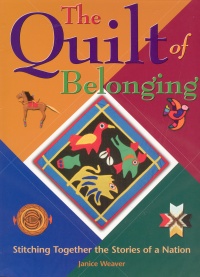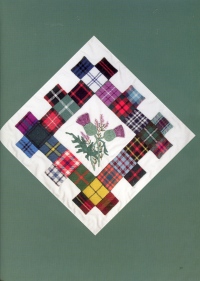| ________________
CM . . .
. Volume XII Number 20 . . . .June 9, 2006 
 |
The Quilt of Belonging: Stitching Together the Stories of a Nation.
Janice Weaver.
Toronto, ON: Maple Tree Press, 2006.
64 pp., pbk., $16.95.
ISBN 1-897066-50-3.
Subject Headings:
Quilts-Canada.
Invitation, the Quilt of Belonging (Organization).
Immigrants-Canada.
Grades 4-7 / Ages 9-12.
Review by Lorraine Douglas.
**** /4 |
| |
|

excerpt:
Like a patchwork quilt, the block for Scotland was made from pieces of leftover cloth. Twenty-eight tiny squares cut from a variety of tartan fabrics - representing some of the clans and regions of Scotland - are arranged around the block’s edges like the thick stone walls of a Highland castle.
At the heart of the block, in the middle of what would be the castle’s courtyard, two thistles sit nestled in a stand of heather. Both plants blanket the hills and valleys of the Scottish Highlands like freshly fallen snow. The Heather, like a four-leaf clover, is believed to bring good luck to anyone who picks it, while the thistle is a symbol of protection. As Scotland’s national emblem, this prickly plant carries the motto “No one harms me without punishment.” Here, the thistles - which seem to be bending their soft purple heads in the breeze - represent the resilience of the Scottish people, as well as their fighting spirit.
This colourful, informative and very interesting book is based on Canada’s largest textile project. There is someone from every country in the world living in Canada, and “The Quilt of Belonging” celebrates Canada’s diversity with blocks representing every country as well as 70 blocks from various Metis, Inuit and Aboriginal groups in Canada.
Esther Bryan is a visual artist who wanted to honour the contributions of all Canadians - old and new. She decided to make a massive quilt, and each block would be prepared by a Canadian with a connection to one of the world’s nations or group in Canada. A volunteer researcher began searching for representatives of each of these groups, and it took close to six years to find all the people and make them a part of the project. The quilt is a metaphorical statement as all the blocks are separate and distinct, but each is connected to its neighbours by a colourful strand of thread.
The author has done an excellent job of describing the history of quilts; the techniques and materials used in the creation of the block; and the symbolism of the visual content of the blocks. She has chosen to highlight dozens of selected blocks in a variety of ways. For example, she has grouped four blocks - from Namibia, Botswana, Denmark and the Plains Cree - together in a section on the theme of stitchery. The creation of the blocks is carefully explained, and she very effectively tells us interesting details about the cultures in a succinct manner. For instance, in the Danish block, she explains that a bicycle appears in the village scene because so many Danes cycle across their low flat country. On the Plains Cree block, the author explains how the four aboriginal colours of man also appear in the medicine wheel block. The medicine wheel block shown later in the book is a special square representing all of Canada’s first peoples. The quilt includes a block for Newfoundland’s Beothuk people who all fell victim to starvation and disease.
 The book would be very useful for school projects and the creation of community quilts as it is very inspiring and has a section on how to make your own square. Not all the countries could be represented in the book, but at the end of the book there is a list of all the countries and groups, and in this section even more photos are included. The book would be very useful for school projects and the creation of community quilts as it is very inspiring and has a section on how to make your own square. Not all the countries could be represented in the book, but at the end of the book there is a list of all the countries and groups, and in this section even more photos are included.
The colour reproductions of the blocks and the entire quilt are beautiful in their sharpness of detail and clarity. The book design is extremely handsome, and its strong colours and easy to read text will make it a very useful book in public and school libraries. Adults, as well as children, will enjoy this tribute to the quilt and the cultural and artistic diversity of Canada.
Highly Recommended.
Lorraine Douglas worked for more than 25 years as a children’s librarian and coordinator of youth services at the Winnipeg Public Library. She is now retired and living in Sidney, BC.

To comment
on this title or this review, send mail to cm@umanitoba.ca.
Copyright © the Manitoba Library Association. Reproduction for personal
use is permitted only if this copyright notice is maintained. Any
other reproduction is prohibited without permission.
NEXT REVIEW |
TABLE OF CONTENTS FOR THIS ISSUE
- June 9, 2006.
AUTHORS |
TITLES |
MEDIA REVIEWS |
PROFILES |
BACK ISSUES |
SEARCH |
CMARCHIVE |
HOME |

 The book would be very useful for school projects and the creation of community quilts as it is very inspiring and has a section on how to make your own square. Not all the countries could be represented in the book, but at the end of the book there is a list of all the countries and groups, and in this section even more photos are included.
The book would be very useful for school projects and the creation of community quilts as it is very inspiring and has a section on how to make your own square. Not all the countries could be represented in the book, but at the end of the book there is a list of all the countries and groups, and in this section even more photos are included.